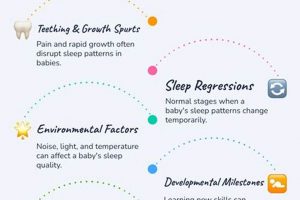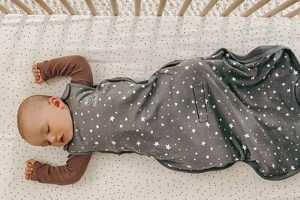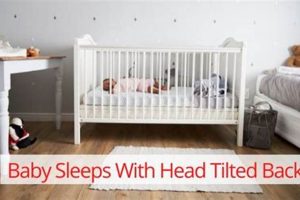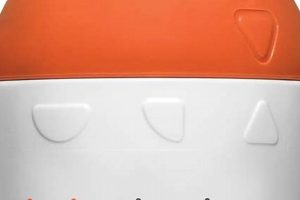Appropriate attire for infants during slumber encompasses a range of garments designed to promote safe and comfortable rest. These resources assist caregivers in selecting suitable fabrics, styles, and layering techniques based on environmental conditions and the child’s individual needs. For example, a resource might recommend a lightweight cotton sleep sack during warmer months or a footed fleece pajama during colder seasons, ensuring the child’s temperature remains regulated throughout the night.
The proper selection of infant sleepwear is paramount for several reasons, including minimizing the risk of overheating, reducing the likelihood of entanglement from loose bedding, and contributing to overall sleep quality. Historically, caregivers relied on intuition and tradition; however, current recommendations emphasize evidence-based practices that prioritize safety and comfort. Utilizing such resources can alleviate parental anxiety and contribute to establishing healthy sleep routines from an early age.
The following sections will delve into specific garment types, material considerations, sizing guidelines, and safety standards to aid in informed decision-making concerning infant sleep attire. This information will provide a foundation for selecting appropriate garments that promote both restful sleep and the well-being of the infant.
Guidance on Infant Sleep Attire
Optimal choices in infant sleepwear contribute significantly to a safe and restful sleep environment. Adherence to established recommendations reduces potential hazards and promotes comfortable rest.
Tip 1: Prioritize Breathable Fabrics: Select natural fibers such as cotton, muslin, or merino wool. These materials facilitate air circulation, minimizing the risk of overheating and maintaining a consistent body temperature.
Tip 2: Consider Room Temperature: Adjust the infant’s attire based on the ambient temperature of the sleep environment. A room thermometer can assist in making informed decisions regarding layering.
Tip 3: Avoid Overbundling: Overdressing an infant can lead to hyperthermia. Adhere to the general guideline of dressing the infant in one layer more than what an adult would find comfortable in the same environment.
Tip 4: Opt for Fitted Styles: Ensure that sleepwear is appropriately sized and fitted to the infant. Loose garments can pose a suffocation hazard or restrict movement.
Tip 5: Eliminate Drawstrings and Decorations: Remove any sleepwear with drawstrings, ribbons, or decorative attachments that could detach and present a choking or strangulation risk.
Tip 6: Transition to Sleep Sacks: Consider the use of sleep sacks or wearable blankets as a safer alternative to loose blankets, particularly for infants under twelve months of age. These garments allow for movement while preventing entanglement.
Tip 7: Regularly Inspect Sleepwear: Routinely examine the infant’s sleepwear for signs of wear and tear, such as loose seams or damaged fasteners. Replace worn or damaged garments promptly.
Adhering to these guidelines promotes infant safety and comfort during sleep. Selecting suitable sleep attire contributes to a more restful and secure sleep environment for both the infant and caregivers.
The subsequent section will address specific concerns regarding common misconceptions about infant sleepwear, providing clarity and reinforcing safe sleep practices.
1. Fabric Breathability
Fabric breathability constitutes a critical element within comprehensive resources on infant sleep attire. The ability of a fabric to allow air circulation directly impacts the infant’s thermal regulation and overall comfort during sleep, thereby minimizing risks associated with overheating and promoting restful sleep.
- Material Composition and Air Permeability
The type of fiber used in the garment significantly influences its breathability. Natural fibers, such as cotton, muslin, and merino wool, possess inherent air permeability due to their structure. These materials allow moisture vapor to escape, preventing the build-up of sweat and maintaining a stable body temperature. Conversely, synthetic fabrics, like polyester or nylon, often exhibit lower breathability, potentially leading to overheating. For example, a sleep sack made of 100% cotton will typically outperform a polyester blend in terms of moisture wicking and airflow.
- Weave and Knit Structure
Beyond the fiber type, the weave or knit structure of the fabric also affects its ability to breathe. Looser weaves and open-knit structures facilitate greater air circulation compared to tightly woven or knit fabrics. A loosely woven muslin swaddle, for instance, allows for better airflow than a densely knit fleece blanket, reducing the risk of overheating, especially in warmer environments. The selection of an appropriate weave is critical to infant sleep safety.
- Moisture-Wicking Properties
The ability of a fabric to wick away moisture is directly related to its breathability. Moisture-wicking fabrics draw perspiration away from the skin, allowing it to evaporate more quickly and maintain a dry and comfortable microclimate around the infant’s body. This is particularly important during sleep, when the infant’s body temperature can fluctuate. Materials like merino wool are renowned for their moisture-wicking capabilities, making them suitable for sleepwear in various climates.
- Impact on Thermal Regulation
Fabric breathability directly impacts the infant’s ability to regulate body temperature. Overheating is a known risk factor for Sudden Infant Death Syndrome (SIDS). Garments that allow for adequate air circulation help prevent the infant from becoming excessively warm during sleep. Caregivers should consider the room temperature and choose breathable fabrics that allow the infant to maintain a stable and safe body temperature throughout the night, consulting recommended resources for appropriate layering strategies.
In summary, the selection of breathable fabrics is paramount when choosing infant sleep attire. Resources guiding caregivers in selecting appropriate garments should emphasize the importance of material composition, weave structure, moisture-wicking properties, and the impact on thermal regulation to minimize the risk of overheating and promote safe and restful sleep for the infant.
2. Safe Layering
Safe layering, a cornerstone of responsible infant care, holds a pivotal position within resources dedicated to appropriate infant sleep attire. The practice involves strategically adding or removing layers of clothing to maintain an optimal body temperature for the infant, mitigating risks associated with overheating and hypothermia during sleep.
- Adaptability to Environmental Conditions
The core principle of safe layering lies in adapting the infant’s attire to the prevailing room temperature. A resource on sleep clothing might suggest a single layer of breathable cotton during warmer months, while recommending additional layers, such as a long-sleeved bodysuit under a sleep sack, during colder periods. This adaptability ensures the infant remains comfortably warm without the danger of overheating, a known risk factor for Sudden Infant Death Syndrome (SIDS).
- The Role of Breathable Materials
Effective layering relies heavily on the use of breathable fabrics, such as cotton, muslin, or merino wool. These materials allow moisture vapor to escape, preventing the build-up of sweat and maintaining a stable body temperature. A resource on sleepwear would emphasize avoiding synthetic fabrics like polyester as a base layer, as they trap heat and moisture, increasing the risk of overheating. For instance, a cotton undershirt paired with a fleece sleep sack offers a balanced approach to thermal regulation.
- Monitoring for Signs of Overheating or Cold Stress
A crucial aspect of safe layering, detailed in guidance, involves vigilant monitoring for signs of discomfort. Caregivers should be attentive to indications of overheating, such as sweating, flushed skin, or rapid breathing, and signs of cold stress, like shivering or cool extremities. The resource might advise adjusting the layers accordingly based on these cues, ensuring the infant’s comfort and safety are continuously prioritized. The back of the neck is often recommended as a reliable indicator of body temperature.
- Age-Appropriate Layering Guidelines
Resources on infant sleep attire often provide specific layering recommendations tailored to the infant’s age and developmental stage. Newborns, who have less developed thermoregulation capabilities, typically require slightly more layers than older infants. These guidelines might include suggestions for swaddling techniques for newborns or transitioning to sleep sacks as the infant becomes more mobile, ensuring safety and comfort as the child grows. A resource would emphasize that loose blankets should be avoided in favor of fitted sleepwear options.
Ultimately, safe layering represents a fundamental concept within the broader discourse on infant sleep safety and responsible caregiving. Resources providing comprehensive guidance on sleep clothing should emphasize the importance of adapting to environmental conditions, selecting breathable materials, monitoring for signs of discomfort, and adhering to age-appropriate guidelines to ensure the infant’s well-being and promote restful sleep.
3. Temperature regulation
Effective temperature regulation represents a critical function within the framework of infant sleep safety and is intrinsically linked to resources concerning suitable sleep attire. The objective is maintaining a stable body temperature for the infant during sleep, avoiding both overheating and hypothermia, conditions that can negatively impact well-being and increase the risk of adverse events, including Sudden Infant Death Syndrome (SIDS). Sleepwear selection directly affects the infant’s ability to thermoregulate; inappropriate clothing choices can impede natural heat dissipation or fail to provide adequate warmth.
Infant sleep clothing guides typically address the impact of fabric type, garment style, and layering techniques on temperature regulation. For example, these resources often recommend breathable natural fibers such as cotton or muslin for warmer environments to facilitate airflow and prevent overheating. Conversely, they might suggest layering a long-sleeved bodysuit under a sleep sack in colder conditions, provided that the caregiver monitors the infant for signs of discomfort. The practical application of these recommendations requires a nuanced understanding of the ambient room temperature and the individual infant’s physiological needs. Caregivers should routinely assess the infant for signs of overheating, such as flushed skin, rapid breathing, or sweating, and signs of cold stress, including shivering or cool extremities.
In conclusion, the connection between temperature regulation and resources regarding sleep attire is vital for ensuring infant safety and comfort. Resources on this topic should provide clear guidelines on selecting appropriate clothing based on environmental factors and individual infant characteristics, emphasizing the importance of monitoring the infant’s temperature and adjusting attire accordingly. This holistic approach promotes optimal thermoregulation, contributing to a safer sleep environment and enhanced infant well-being.
4. Proper sizing
Optimal fit is paramount when selecting infant sleepwear, and guidelines consistently address this crucial aspect. Clothing that is too large presents safety hazards; loose fabric can pose a suffocation risk or become entangled, restricting movement and potentially leading to overheating if the infant becomes trapped beneath it. Conversely, attire that is too small may restrict circulation, cause discomfort, or impede normal development, particularly during periods of rapid growth. Selecting correctly sized garments mitigates these risks, ensuring the infant’s safety and comfort throughout the sleep cycle. For example, a sleep sack that extends significantly beyond the infant’s shoulders increases the likelihood of the infant slipping down inside, whereas a footed pajama that constricts the feet could impede movement and lead to discomfort.
Accurate measurement and adherence to sizing charts provided by manufacturers are essential practices. While age-based sizing can serve as a general guide, individual infants vary in size and proportions. Measurement of the infant’s height and weight provides a more precise indication of the appropriate size. Furthermore, garment design influences the fit; certain styles may run smaller or larger than others. Consultation with a resource offering guidance on infant sleep attire can aid caregivers in interpreting sizing charts and selecting garments that accommodate the infant’s specific measurements. Consistent monitoring of the infant’s growth and adjustment of sleepwear accordingly is crucial to maintain safety and comfort. An example scenario would be an infant nearing the upper weight limit for a specific size sleep sack, necessitating a transition to the next size to ensure sufficient room for movement.
In summary, appropriate sizing constitutes an indispensable element of safe and effective infant sleepwear. Resources that provide information about infant sleep attire must emphasize the importance of accurate measurement, adherence to sizing guidelines, and continuous monitoring of fit to mitigate safety hazards and promote optimal comfort and well-being. The selection of correctly sized garments minimizes the risk of suffocation, entanglement, and restricted movement, contributing to a safer and more restful sleep environment for the infant.
5. Snug fit
The term “snug fit,” when applied to infant sleep attire, denotes a close-fitting design intended to reduce the risk of entanglement and suffocation associated with loose-fitting garments. Guidance on appropriate infant sleep clothing consistently emphasizes the importance of a snug, yet non-restrictive, fit as a cornerstone of safe sleep practices.
- Reduction of Suffocation Risk
The primary benefit of snug-fitting sleepwear lies in its ability to minimize the potential for loose fabric to cover the infant’s face, thereby reducing the risk of suffocation. Baggy clothing or ill-fitting blankets can easily become dislodged during sleep, posing a hazard, particularly for younger infants who lack the motor skills to remove the obstruction. A snug fit ensures that the garment conforms to the infant’s body, limiting excess material that could migrate and impede breathing. For example, a well-fitted sleep sack made from breathable fabric offers warmth without the risks associated with loose blankets.
- Prevention of Entanglement
Snug-fitting sleepwear mitigates the risk of entanglement. Loose sleeves, pant legs, or decorative elements can pose a danger if the infant becomes entangled during sleep. Snug-fitting garments minimize the opportunity for limbs to become trapped, promoting safer and more restful sleep. For instance, a footed pajama with elasticized cuffs provides a snug fit around the ankles, reducing the likelihood of the feet becoming entangled within the garment itself.
- Facilitation of Movement Without Restriction
The term “snug fit” should not be misconstrued as “tight fit.” Appropriate snug-fitting sleepwear allows for a full range of movement without constriction. The garment should conform to the infant’s body shape without impeding circulation or hindering comfortable movement. Stretchy fabrics, such as those containing elastane or spandex, contribute to a snug yet flexible fit. A properly fitted bodysuit, for example, allows the infant to stretch and kick freely while maintaining a close-to-body fit.
- Guidance on Size Selection
Sleep clothing guidance typically provides detailed sizing charts and recommendations to assist caregivers in selecting appropriately sized snug-fitting garments. These resources emphasize the importance of measuring the infant’s height and weight to ensure accurate fit. They also advise against purchasing sleepwear with the intention of “growing into it,” as oversized garments present a significant safety hazard. Proper sizing is paramount to achieving the intended benefits of a snug fit; clothing that is too large or too small compromises safety and comfort.
In conclusion, the concept of “snug fit” is integral to resources that disseminate information about safe infant sleep practices. Garments designed with a snug fit reduce the risk of suffocation and entanglement, while still permitting comfortable movement. Adherence to sizing guidelines ensures that the garment conforms appropriately to the infant’s body, maximizing safety and promoting restful sleep. A correctly implemented “snug fit” strategy is a critical element in maintaining a safe sleep environment for infants.
6. Material safety
The assurance of material safety forms a cornerstone of any comprehensive resource dedicated to infant sleep attire. The selection of fabrics used in infant sleepwear directly impacts the child’s health and well-being. Harmful chemicals, dyes, or finishes present in unsafe materials can leach into the skin, potentially causing allergic reactions, skin irritations, or even more serious health concerns. Therefore, a credible resource will prioritize materials that have undergone rigorous testing and certification to ensure they are free from harmful substances. This focus on material safety reflects the understanding that the very clothing designed to promote rest and security should not inadvertently pose a health risk to the vulnerable infant population.
Guidance will often specify certifications such as OEKO-TEX Standard 100, which indicates that the fabric has been tested for a wide range of harmful substances and is deemed safe for direct contact with skin. Real-life examples include recommendations for sleep sacks made from organic cotton, cultivated without the use of synthetic pesticides or fertilizers, minimizing the infant’s exposure to potentially harmful chemicals. Resources might also advise caregivers to avoid sleepwear treated with flame retardants, unless absolutely necessary and explicitly certified as safe, due to concerns about their potential long-term health effects. The practical significance of this understanding lies in empowering parents to make informed choices, selecting sleep attire that prioritizes the infant’s health and minimizes exposure to potentially harmful substances.
In summary, the emphasis on material safety within resources pertaining to infant sleep clothing serves as a critical safeguard for infant health. The responsible selection of fabrics free from harmful substances, coupled with adherence to recognized safety certifications, significantly reduces the risk of adverse health effects. While challenges remain in identifying and regulating all potentially harmful substances, the commitment to material safety remains a fundamental principle in the pursuit of safe and comfortable sleepwear for infants, contributing to their overall well-being.
7. Minimal embellishments
Infant sleepwear guidelines universally emphasize the principle of minimal embellishments. This recommendation is a direct response to the inherent safety hazards posed by decorative elements such as buttons, ribbons, appliques, and drawstrings. These seemingly innocuous additions can detach from the garment, creating choking hazards for the infant. Moreover, longer embellishments, like ribbons or drawstrings, present a strangulation risk. The absence of such features is therefore not merely an aesthetic choice but a crucial safety consideration, directly contributing to a secure sleep environment. For example, a sleep sack with a sewn-on bow, while visually appealing, introduces an unnecessary risk compared to a plain, unadorned sleep sack made from the same material.
The practical application of this understanding involves careful scrutiny of sleepwear before purchase and regular inspection of existing garments. Caregivers should meticulously check for loose threads, insecurely attached embellishments, and any signs of wear and tear that could compromise the integrity of the garment. Resources may provide checklists of potential hazards to aid in these inspections. Furthermore, advocacy groups often disseminate information about product recalls related to embellishments detaching from infant clothing, underscoring the ongoing nature of this safety concern. Compliance with this principle necessitates a shift in focus from purely aesthetic considerations to prioritizing the functional safety of sleepwear.
In summary, the directive for minimal embellishments in infant sleep clothing serves as a primary preventative measure against choking and strangulation hazards. While complete elimination of risk may be unattainable, adherence to this guideline significantly reduces the likelihood of adverse events. Challenges persist in balancing consumer preferences for visually appealing garments with the overriding need for safety, but clear communication and consistent enforcement of safety standards are vital to maintaining a secure sleep environment for infants.
Frequently Asked Questions
The following questions address common concerns and misconceptions regarding infant sleep clothing. The information provided is intended to promote safe sleep practices and inform parental decision-making.
Question 1: What constitutes the primary safety concern regarding infant sleepwear?
Suffocation poses the most significant risk. Loose bedding and ill-fitting garments can obstruct an infant’s airway, leading to potentially fatal consequences. Strict adherence to safe sleep guidelines, including the use of fitted sheets and appropriately sized sleepwear, is critical.
Question 2: Is it advisable to use blankets in an infant’s crib?
Blankets are generally discouraged for infants under 12 months due to the risk of suffocation. Sleep sacks or wearable blankets are recommended as safer alternatives to provide warmth without the hazard of loose bedding.
Question 3: How does room temperature factor into sleepwear selection?
Room temperature directly impacts the choice of sleep attire. Overheating is a known risk factor for Sudden Infant Death Syndrome (SIDS). Caregivers should adjust the infant’s clothing based on the ambient temperature, avoiding excessive layering that could lead to hyperthermia.
Question 4: What materials are considered safest for infant sleepwear?
Breathable, natural fibers such as cotton, muslin, and merino wool are generally preferred. These materials facilitate air circulation, minimizing the risk of overheating. Synthetic fabrics should be used with caution, as they may trap heat and moisture.
Question 5: Are accessories permitted in infant sleepwear?
Accessories such as bows, ribbons, and drawstrings are strongly discouraged due to the risk of choking and strangulation. Any embellishments should be securely attached and regularly inspected for potential hazards.
Question 6: How frequently should infant sleepwear be assessed for proper fit?
Given the rapid growth of infants, sleepwear should be evaluated for fit on a regular basis, ideally weekly. Garments that are too tight can restrict movement and circulation, while those that are too loose pose a suffocation hazard.
These questions provide a concise overview of key considerations related to infant sleep attire. Prioritizing safety and comfort through informed decision-making is essential for promoting healthy sleep habits and minimizing potential risks.
The next article section will present a comprehensive checklist to aid caregivers in selecting appropriate sleep garments.
Conclusion
This exploration of baby sleep clothing guide has illuminated essential considerations for ensuring infant safety and well-being during sleep. Key elements include prioritizing breathable fabrics, implementing safe layering techniques, adhering to appropriate sizing, and meticulously avoiding embellishments that pose choking or strangulation hazards. The selection of sleepwear directly impacts the infant’s ability to regulate body temperature and minimizes the risk of suffocation and entanglement.
The information presented herein underscores the critical role of informed decision-making in safeguarding infant health. Consistent application of these principles will contribute to creating a safer sleep environment. Continued vigilance and adherence to established safety standards are imperative for protecting this vulnerable population.







